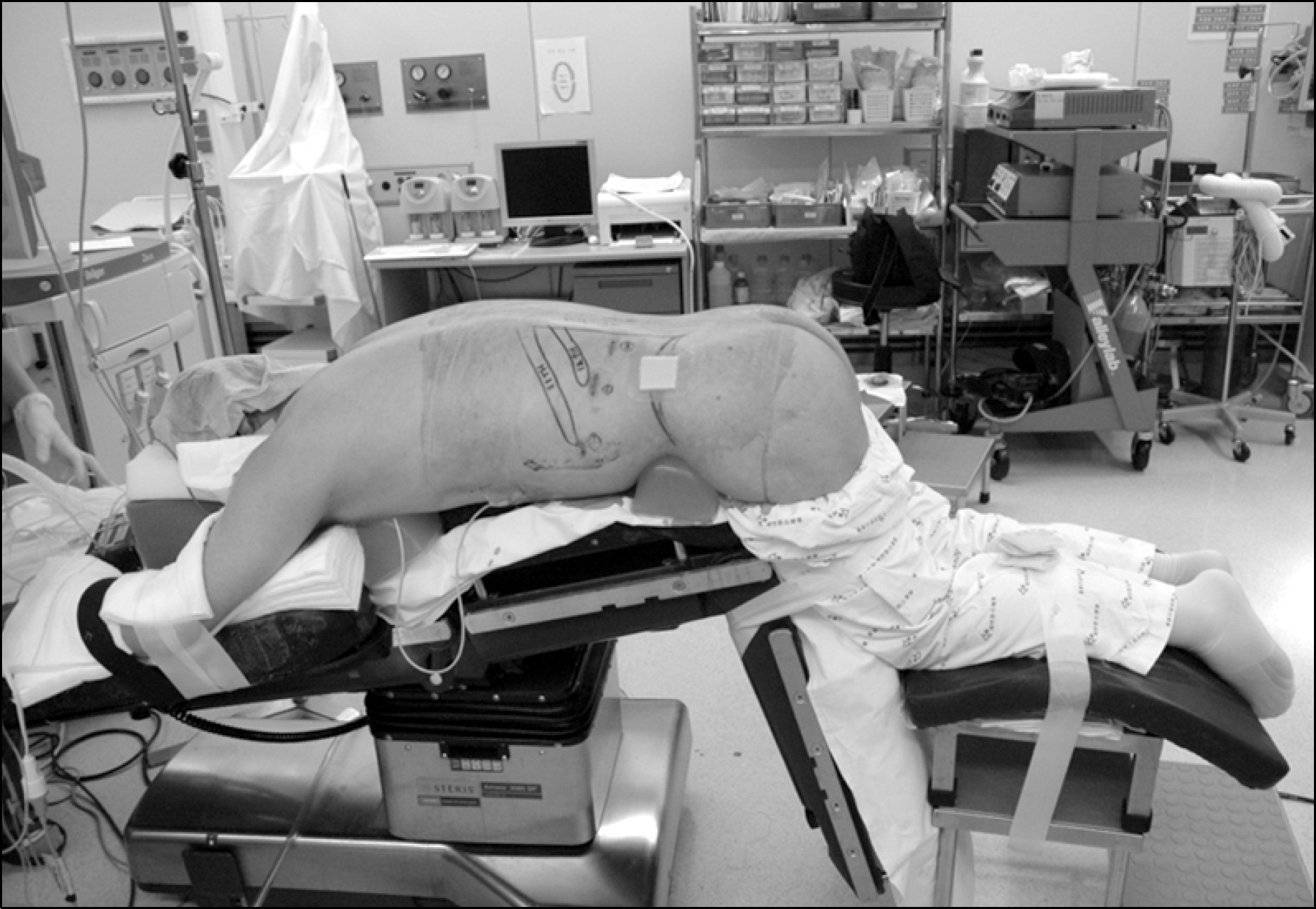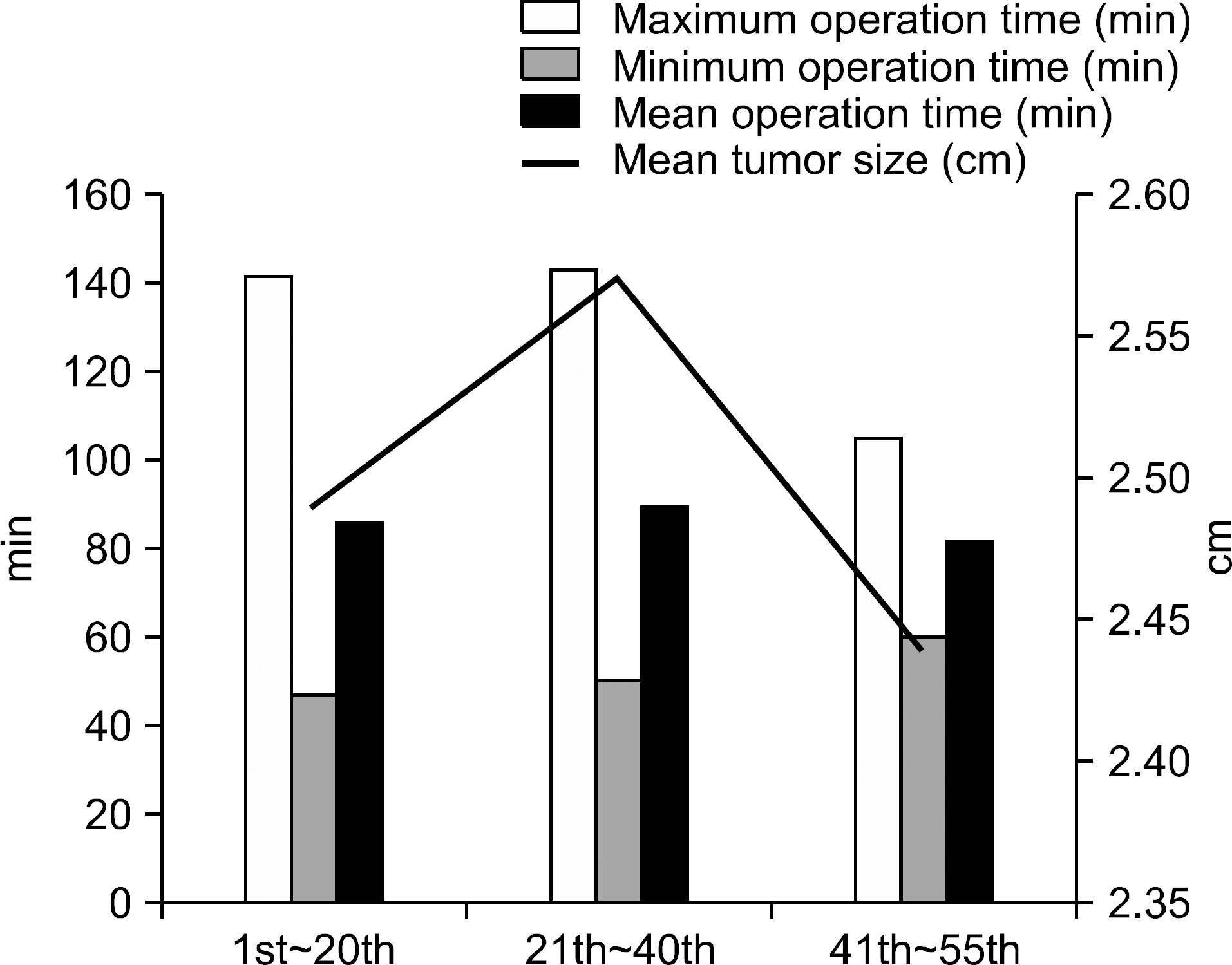Abstract
Purpose:
Posterior retroperitoneoscopic adrenalectomy (PRA) for small adrenal tumors has recently been in the spotlight due to its several benefits. Compelling advantages for endoscopic surgeons include direct, safe, and fast approach to the adrenal gland without trespass to the intraperitoneal organ. This study reports our initial experiences of PRA for the management of adrenal tumors.
Methods:
From December 2009 to August 2011, 63 patients underwent PRA for the management of adrenal tumor. Among these patients, laparoscopic adrenalectomy and robotic adrenalectomy were performed in 54 and nine patients, respectively. We retrospectively reviewed records of all surgical outcomes.
Results:
Of the 54 patients, 22 were male and 32 were female, and mean age was 51.7±14.0 years. Mean body mass index was 24.6±3.6 kg/m2 and mean dimension of the tumors was 2.66±1.36 cm. Six patients were diagnosed with Cushing's disease, 22 patients with primary aldosteronism, seven patients with pheochromocytoma, one patient with metastatic adrenal gland cancer, and 18 patients with nonfunctioning adrenal tumors. Mean operative time was 88.5±27.1 min, mean blood loss was 17.4±37.4 ml, and mean duration to first oral intake was 0.83±0.4 days. Mean number of postoperative analgesics used was 2.28±2.54, and mean postoperative hospital stay was 2.85±1.43 days. There was no open conversion during the operation and no post-operative complication.
Go to : 
REFERENCES
1.Gagner M., Lacroix A., Bolté E. Laparoscopic adrenalectomy in Cushing's syndrome and pheochromocytoma. N Engl J Med. 1992. 327:1033.

3.Zacharias M., Haese A., Jurczok A., Stolzenburg JU., Fornara P. Transperitoneal laparoscopic adrenalectomy: outline of the preoperative management, surgical approach, and outcome. Eur Urol. 2006. 49:448–59.

4.Moinzadeh A., Gill IS. Laparoscopic radical adrenalectomy for malignancy in 31 patients. J Urol. 2005. 173:519–25.

6.Gill IS., Meraney AM., Thomas JC., Sung GT., Novick AC., Lieberman I. Thoracoscopic transdiaphragmatic adrenalectomy: the initial experience. J Urol. 2001. 165:1875–81.

7.Mercan S., Seven R., Ozarmagan S., Tezelman S. Endoscopic retroperitoneal adrenalectomy. Surgery. 1995. 118:1071–5.

8.Berber E., Mitchell J., Milas M., Siperstein A. Robotic posterior retroperitoneal adrenalectomy: operative technique. Arch Surg. 2010. 145:781–4.
9.Li QY., Li F. Laparoscopic adrenalectomy in pheochromocytoma: retroperitoneal approach versus transperitoneal approach. J Endourol. 2010. 24:1441–5.

10.Rubinstein M., Gill IS., Aron M., Kilciler M., Meraney AM., Finelli A, et al. Prospective, randomized comparison of transperitoneal versus retroperitoneal laparoscopic adrenalectomy. J Urol. 2005. 174:442–5.

11.Kang WH., Kim BS., Choi YB. Comparison of laparoscopic transperitoneal versus retroperitoneal adrenalectomy. J Korean Soc Endosc Laparosc Surg. 2010. 13:22–5.
12.Shen WT., Kebebew E., Clark OH., Duh QY. Reasons for conversion from laparoscopic to open or hand-assisted adrenalectomy: review of 261 laparoscopic adrenalectomies from 1993 to 2003. World J Surg. 2004. 28:1176–9.

13.Tiyadath BN., Sukumar S., Saheed CS., Hattangadi SB. Laparoscopic adrenalectomy –- is it any different in phaeochro-mocytoma and non-phaeochromocytoma? Asian J Surg. 2007. 30:244–9.
14.Zhang XP., Wei JX., Zhang WX., Wang ZY., Wu YD., Song DK. Transperitoneal laparoscopic adrenalectomy for adrenal neoplasm: a report of 371 cases. Ai Zheng. 2009. 28:730–3.

15.Whittle DE., Schroeder D., Purchas SH., Sivakumaran P., Conaglen JV. Laparoscopic retroperitoneal left adrenalectomy in a patient with Cushing's syndrome. Aust N Z J Surg. 1994. 64:375–6.

16.Suzuki K., Kageyama S., Hirano Y., Ushiyama T., Rajamahanty S., Fujita K. Comparison of 3 surgical approaches to laparo-scopic adrenalectomy: a nonrandomized, background matched analysis. J Urol. 2001. 166:437–43.

17.Mazzaglia PJ., Vezeridis MP. Laparoscopic adrenalectomy: balancing the operative indications with the technical advances. J Surg Oncol. 2010. 101:739–44.

18.Giebler RM., Behrends M., Steffens T., Walz MK., Peitgen K., Peters J. Intraperitoneal and retroperitoneal carbon dioxide insufflation evoke different effects on caval vein pressure gradients in humans: evidence for the starling resistor concept of abdominal venous return. Anesthesiology. 2000. 92:1568–80.
19.Walz MK., Alesina PF., Wenger FA., Deligiannis A., Szuczik E., Petersenn S, et al. Posterior retroperitoneoscopic adrenalectomy–results of 560 procedures in 520 patients. Surgery. 2006. 140:943–8.

20.Giebler RM., Walz MK., Peitgen K., Scherer RU. Hemodynamic changes after retroperitoneal CO2 insufflation for posterior retroperitoneoscopic adrenalectomy. Anesth Analg. 1996. 82:827–31.

21.Berber E., Tellioglu G., Harvey A., Mitchell J., Milas M., Siperstein A. Comparison of laparoscopic transabdominal lateral versus posterior retroperitoneal adrenalectomy. Surgery. 2009. 146:621–5.

22.Fernández-Cruz L., Saenz A., Benarroch G., Astudillo E., Taura P., Sabater L. Laparoscopic unilateral and bilateral adrenalectomy for Cushing's syndrome. Transperitoneal and retroperitoneal approaches. Ann Surg. 1996. 224:727–34.
Go to : 
Table 1.
Patient's characteristics (n=54)
Table 2.
Operative outcomes of PRA (n=54)




 PDF
PDF ePub
ePub Citation
Citation Print
Print




 XML Download
XML Download